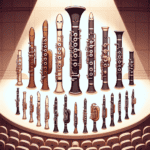The clarinet ligature plays a key role in clarinet performance. While often overlooked, choosing the right ligature can greatly affect your sound quality, tuning, and overall playing experience. This guide covers what a ligature is, the different types available, and how to pick the best one for you.
What is a Clarinet Ligature?
A clarinet ligature holds the reed onto the mouthpiece. This small but important part is vital for producing sound and articulation. Without it, the reed wouldn't stay put, and you wouldn't be able to create the vibrations needed to make music.
Types of Clarinet Ligatures
Knowing about the different ligature types can help you choose wisely:
| Ligature Type | Characteristics | Best For |
|---|---|---|
| Metal | Durable, bright sound, easy to adjust | Professional players, classical music |
| Leather | Warm, flexible, rich sound | Jazz players, softer articulation |
| Fabric | Unique tone, less intrusive | Players seeking distinct sound |
| Hybrid | Versatile, combines material benefits | Players wanting flexibility |
Factors to Consider When Choosing a Ligature
When picking a ligature, think about:
- Playing Style: Your style affects which ligature works best. Jazz players might prefer leather for flexibility, while classical musicians might choose metal for projection.
- Reed Type: Match your ligature to your reed strength. Softer reeds work well with forgiving ligatures, while harder reeds need a tighter grip.
- Comfort and Adjustment: Find a ligature that feels good on your mouthpiece and is easy to adjust. This matters for long playing sessions and trying different sounds.
How to Properly Attach a Ligature
Attaching your ligature correctly is key for good sound:
- Moisten the Reed: Wet your reed for better response. Soak it in water or use your mouth.
- Position the Reed: Place the reed firmly on the mouthpiece tip, making sure it's lined up perfectly.
- Slide on the Ligature: Gently put the ligature over the reed, about one-third down. This placement affects the sound.
- Secure the Ligature: Tighten evenly to avoid too much pressure on the reed. It should hold the reed firmly but let it vibrate freely.
Maintenance Tips for Ligatures
Taking care of your ligature helps it last longer and perform better:
- Regular Cleaning: Wipe down your ligature after each use. Polish metal ones to prevent tarnish, and dust leather or fabric types.
- Storage: Keep your ligature in a safe place when not in use. A protective case is ideal.
- Check for Wear: Regularly look for signs of wear or damage, especially on fabric or leather. Replace it if it doesn't hold the reed well or affects your sound.
The Role of Quality in Performance
The quality of your ligature directly impacts your performance. A well-made ligature from a good brand, like Martin Freres, brings out the best in your clarinet and reed. Investing in a quality ligature can improve your sound and make playing more enjoyable.
Experienced players often match their ligature to their clarinet's quality. A well-crafted ligature complements a fine instrument, letting musicians fully explore their sound.
Whether you're new to clarinet or a seasoned player, understanding the importance of the ligature is key to improving your technique. The right ligature affects both your sound and comfort while playing. Take time to explore your options and see how a quality ligature can boost your clarinet playing.







